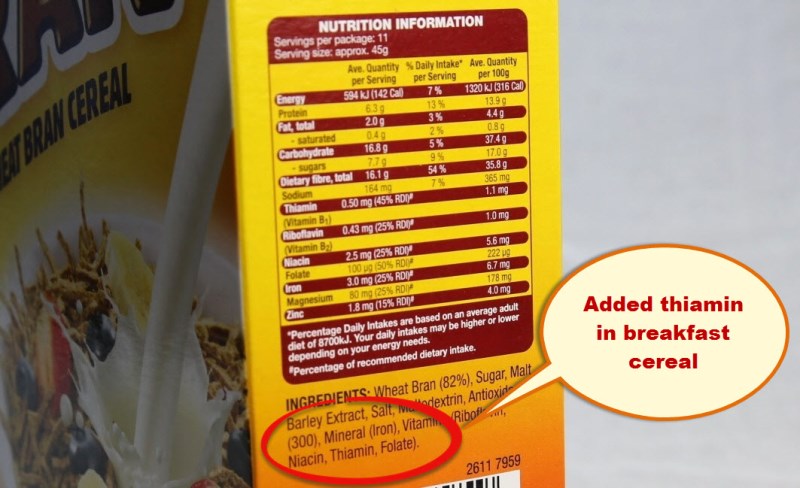What is thiamin (vitamin B1)?

Thiamin is one of the B group of vitamins and is known as B1 because it was the first of them to be discovered. It helps your cells release energy from carbohydrates and maintains the health of your nervous and digestive systems. It’s popular these days as a hangover remedy and for “executive stress” due to its “theoretical effects” on mood and mental performance. It is water-soluble and so can be leached into the cooking water and lost.
What does thiamin do in the body?
Thiamin performs many important functions. It:
- metabolises carbohydrate (the more carbs you eat, the more thiamin you’ll need)
- releases energy into the body from food
- normalises appetite and digestion
- promotes the proper functioning of the heart and nervous system
- and counters the harmful effects of excess alcohol.
How much thiamin do I need?
The Recommended Dietary Intakes* (RDIs) for thiamin per day are:
Adults
1.1 mg (women) and 1.2 mg (men)
Children
0.5 mg (1-3 yrs)
0.6 mg (4-8 yrs)
0.9 mg (9-13 yrs)
1.1 mg girls (14-18 yrs)
1.2 mg boys (14-18 yrs)
*NRVs from NHMRC Australia and New Zealand 2006
Safe upper limit for thiamin
This cannot be estimated precisely but 100 mg a day is considered a prudent maximum intake – this is what you’ll get from a single ‘executive stress’ B vitamin supplement. That said, there doesn't appear to be significant bad side effects and any excess is excreted via your urine.
List of foods rich in thiamin
Thiamin is found in a number of foods, notably whole (unrefined) grains, nuts, seeds, and lean meats particularly organ meats or offal. Here’s a list of the richest food sources of thiamin, both natural and fortified:
- yeast extract e.g. Vegemite, Marmite, Promite, Aussimite
- malted milk powders e.g. Activite, Horlicks, Milo, Ovaltine which are fortified
- wheat germ
- nuts, especially cashews, peanuts, Brazils, pistachios and pine nuts
- most breakfast cereals are fortified with B1 at the level of 25% of the RDI or 0.28mg per serve as well as B2, niacin and folate, which are other B vitamins
- liver
- kidney
- lean pork - richer than beef or chicken
- green peas
- wholemeal flour
- wholemeal bread
- white bread (by law, all bread is fortified with B1 in Australia)
- seeds, especially sunflower and sesame seeds
Note: the B vitamins work best as a group and so are often grouped together as the B group or B complex vitamins in food and supplements. You need them all!
Fortification with thiamin
Many countries including Australia, USA and UK have added thiamin to staple foods such as flour and bread for many years. In Australia, flour was first enriched with added thiamin in 1991 and today almost all flour for baking bread has added thiamin. You can check this on the food label on the list of ingredients.

Breakfast cereals were one of the first foods to be enriched with thiamin in order to replace the losses during the manufacture of cereals (due to heat, milling/refining). This happened back in the 1960s and they are still the key food group for fortification today.
Easy ways get your recommended day's intake of 1 mg (figures in mg):
It’s relatively easy to get enough thiamin as the vitamin is added to many cereals and breads - thiamin is one of the four vitamins added to most fortified products. Look for the word ‘thiamin’ under the Vitamins on a food label.
Small amounts in many different foods all add up over a day. Below are 3 easy ways to to meet your recommended intake for the day. Refined food such as sugar, oils and many processed foods have little or none.
- Ham sandwich (50 g ham, 2 slices wholemeal) OR
- Bowl (50 g) muesli with 1-2 tablespoons rice bran OR
- Bowl cereal (40 g) plus 1 tablespoon (20 g) wheatgerm.
Deficiency signs
Loss of appetite, feeling weak and tired, or lack of energy are the initial signs. As deficiency progresses, you’ll see oedema (fluid accumulating in the abdomen), shortness of breath, muscle weakness, which progresses to sensory disturbances (loss of feeling in the limbs and feet), paralysis, heart failure, and brain damage called the Wernicke-Korsakoff syndrome which is a potentially fatal neurological disorder that leads to confusion, memory loss and psychosis.
Today thiamin deficiency is rare in developed countries and, if it occurs, is mainly due to heavy alcohol intake e.g. amongst chronic binge drinkers and those who have developed liver disease.
Severe clinical deficiency of thiamin is known as beriberi which is the classic B1 deficiency disease. It has been known for centuries and was first noted in rice-based countries of Asia, due to the reliance on low-nutrient polished white rice as a staple food. The vitamin (like most other vitamins and minerals in grains) is located in the brown outer layers of the rice grain which are removed during rice milling. Beriberi was also prevalent in the prisoner of war camps run by the Japanese in WWII.



